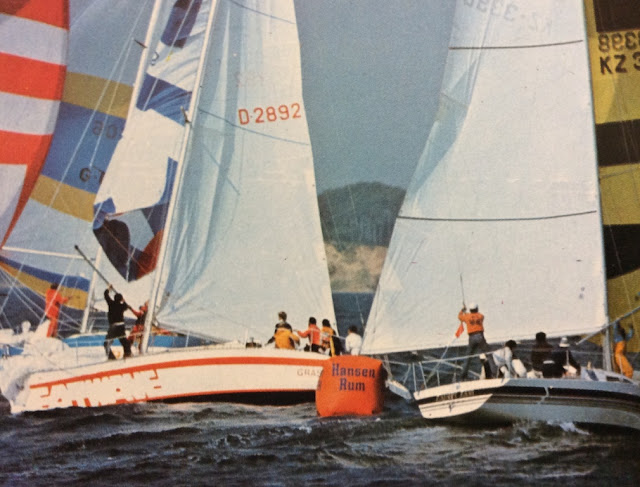 |
| Original profile drawing for Checkmate |
Following that performance, Young carried out some major surgery to Checkmate, to the extent that the fiberglass yacht was cut in half, retaining the bow sections while long hours were spent fitting a new after section. Also discarded was the keel which was substituted by a 800lb weighted centreboard that, originally, was able to automatically gybe three degrees to weather and gave a definite advantage when beating, particularly in a breeze. The old name was also discarded, and the yacht emerged as Heatwave.
 |
| Checkmate during the 1977 New Zealand One Ton Nationals (above and below) |
 The bow sections were not left completely untouched, however, with the introduction of a new sharp upward curve in sheerline, combined with a 'stepped' concave stem profile (similar to Stephen Jones’ English Quarter Tonner Odd Job) – an approach that appeared to allow the forward girth station to be moved aft while retaining maximum waterline length for’ard. Her rig utilised a swept-back spreader concept, with a small set of spreaders for the lower inboard stay, and did not appear to be as sophisticated the in-line set up used on her Farr competitors, nor, in the end, as robust.
The bow sections were not left completely untouched, however, with the introduction of a new sharp upward curve in sheerline, combined with a 'stepped' concave stem profile (similar to Stephen Jones’ English Quarter Tonner Odd Job) – an approach that appeared to allow the forward girth station to be moved aft while retaining maximum waterline length for’ard. Her rig utilised a swept-back spreader concept, with a small set of spreaders for the lower inboard stay, and did not appear to be as sophisticated the in-line set up used on her Farr competitors, nor, in the end, as robust. Heatwave featured the longest rated length and widest beam aft of all the top boats that entered the 1977 One Ton Cup trials, which suggested high theoretical speed. However, in a fixed rating class length had to be paid for, and was offset in Heatwave's case through a more voluminous underbody and significantly greater displacement, and a relatively modest sail plan.
Heatwave did go on to be the surprise performer of the New Zealand trials for the team to contest the 1977 One Ton Cup. While she was generally considered to be the fastest boat on a tight reach, she suffered a broken mast in the first race, and had to scramble to put a new rig in the boat in time for the second race, in which she finished a lowly tenth. However, Heatwave recovered to finish in third place In the medium offshore race - she was the only boat to head Smackwater Jack in the outer Gulf, leading from Groper Rock to Channel Island, but she was headed by the superior capabilities of Smackwater Jack and Jenny H to windward, and suffered from damage to her cockpit instrumentation. She then backed that up with a second in the fourth race and a modest sixth in the final race.
 |
| Heatwave during the first race of the 1977 One Ton Cup, behind Result (KC2998) and Rockie (US2900) |

 |
| Heatwave leads Mr Jumpa and The Red Lion around the first mark in the second race of the One Ton Cup |
 |
| Heatwave on a downwind leg during the 1977 One Ton Cup |
 |
| Heatwave powers along upwind during the 1977 One Ton Cup (photo Facebook) |
 |
| Heatwave sails up the Rangitoto Channel during the 1977 One Ton Cup (photo Maritime Museum) |
 |
| Heatwave arrives back at Westhaven after a race in the 1977 One Ton Cup |
 |
| Heatwave leads Export Lion around a gybe mark during one of the inshore races during the 1978 One Ton Cup |
 |
| Heatwave during the 1978 One Ton Cup |
Heatwave may well have won the series had she not met such light airs in the first race. In that race, and although she was faster in light airs than she had been a year earlier, she finished a calamitous 16th. But Heatwave followed this with a second, sixth and a first, for fourth overall, and in three of the four races, including both offshore races, she led around the first weather mark.
Heatwave has since been based in Europe, and more recent photoa from circa-2003 are shown above and below.




No comments:
Post a Comment